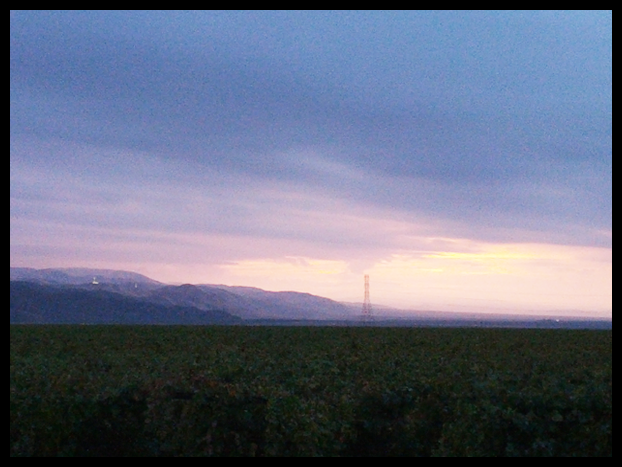Driving the San Joaquin Valley
An afternoon with Starbucks customers in the armpit of California.
The nearly three hundred flat miles of Interstate 5 running through California’s San Joaquin Valley are some of the most loathed in America. If travelers stop at all along this section of highway, it’s to visit the Petro stations, Starbucks, Del Tacos, and In-N-Out Burgers that dot the roadside. In the parking lots of these chain stores, drivers lean against their cars and smoke cigarettes, enjoying a moment of sunshine before quickly resuming their trip. Though the San Joaquin Valley, together with the Sacramento Valley, produces a quarter of America’s produce, many Californians refer to the area as “the armpit of California,” dismissing it as a roadside bathroom break, or joking about it being the haunt of rednecks and meth-heads.
“I don’t even know what town I’m in,” said Alex, a thirty-three-year-old Angeleno I met outside a Starbucks on I-5 between the tiny towns of Mettler and Lebec. “I just got out of the car. I’m ready to leave.” Alex chewed gum and leaned against the fence. With her black hair piled on top of her head, she wore black leggings under a long black sweater with a skeleton’s ribs printed on the front. Growing up in Los Angeles, she’d driven this stretch of highway many times but preferred to pass the time sleeping or playing cards.
Built at the center of a vast parking lot between a McDonald’s and a Mobil gas station, the Starbucks had a long line inside and a busy drive-through. When two men pulled up in a dark minivan, I asked if I could talk with them about the area. One of the men, who gave his name as René, was a German-born cameraman driving from Los Angeles to Silicon Valley to shoot a corporate film for Mercedes. He and his traveling companion, who was also a cameraman, drove through the valley a few times a year. René knew it was important as an agricultural region. But, he said, the four-year-long drought in California was a sign that farmers needed to shift gears. “You read stuff on the Internet,” he said, “and I guess it’s true, how much water is needed to raise one pound of chicken meat, or how much water is needed to grow one tomato. Those are scary numbers. I would really think that everybody would blame Los Angeles—and yes, the front lawns, that might be a problem when they water them excessively, but it’s not that bad. What we use on a daily basis, as far as drinking, showering and all that, is nothing compared to what agriculture seems to need, if you really learn about these numbers, man.”
Over 250 crops are grown in the San Joaquin Valley, including almonds, peaches, mandarins, olives, wine grapes, table grapes, raisins, nectarines, plums, pistachios, walnuts, onions, carrots, garlic, wheat, lettuce, and 84 percent of California’s dairy products. Valley agriculture grosses over $25 billion annually. The agriculture industry accounts for about 80 percent of the state’s water usage. Right now, the region is suffering one of the worst droughts in a century. In the past two years, rain and snow were scarce. Reservoirs dried up. Farmers received little to no surface water, so many drilled new wells and irrigated crops with groundwater. Now the water table is dropping and turning salty. Some growers have cut down almond and fruit trees, and others have left fields fallow. This month, the state’s governor, Jerry Brown, issued an executive order reducing water usage by 25 percent across the state.
California is the last western state to allow landowners to drill wells and extract groundwater on their land with few to no restrictions. In response to criticism over the long-term environmental effects, and the state’s rapidly drying wells, the legislature passed a law last year mandating that local agencies limit groundwater extraction by 2040. “At that pace, it will be nearly 30 years before we even know what is working,” wrote Jay Famiglietti, the NASA Jet Propulsion Laboratory’s senior water scientist, in a Los Angeles Times op-ed. “By then, there may be no groundwater left to sustain.”
A white wooden fence circled the Starbucks parking lot, as if to counteract the irritation of long drive-through lines with the illusion of the pastoral. In the surrounding flatlands, pumpjacks pulled oil from beneath the soil. But despite the ugly commercial architecture, this area can be beautiful. In the San Emigdio Mountains to the southwest, native oaks spill down ravines, breaking the golden slopes with threads of green. In fall, low clouds coat the mountaintops. In spring, rains turn the hills lush with green grasses, imparting a coastal quality as radiant as anything near Santa Barbara. At sunset any time of year, the sky casts everything a rock-rose pink.
Nearby, a middle-aged couple sat at an outside table, sucking drinks through straws. Don, a retired journalist, and Caroline, a fifty-five year old government worker, were headed home to Oakland after a 2,000-mile road trip that took them through Death Valley, Monument Valley, and Canyon de Chelly. From here, they would drive I-5 north and turn west to Monterey. They didn’t drive the 5 much. “Not if we can help it,” Don said with a laugh. “You want to take 101. 101’s nice.” Don sucked the last of his drink through his straw and licked his lips. “The coast, to me, is more interesting than the valley.”
Around us, blackbirds patrolled the parking lot for scraps. A lone seagull landed on a McDonald’s light pole across the parking lot. An older man in a pearl-button shirt, dark jeans, and brown cowboy boots walked inside talking on his phone. “You’re holdin’ us up,” he said, “be reasonable.” Nearby, a guy told his girlfriend, “OK, four more hours,” as they climbed into a Prius, presumably bound for San Francisco.
Two young men walked across the lot carrying Carl’s Jr. to-go bags, wearing thick black-rimmed glasses, skinny jeans, and T-shirts. They told me they worked in media and were driving home to San Diego from a conference they had attended in Oakland. “It was pretty dusty when we came this way,” one of the men, Steven, said. “Like, super dusty. I have no idea what it was. Seems like they were harvesting a bunch of shit.”
Much of the dust wasn’t from the drought; it was pollution from San Francisco. Coastal winds blow Bay Area smog east, where it gets trapped in the valley, particularly in the southern section, which is surrounded by mountains on three sides. The haze this day had come on the heels of a week of dangerously high levels of ozone and fine particle matter called PM-2.5—a hazardous mix of chemicals, microscopic soot, and assorted debris—that sometimes tasted of metal and smoke. According to the EPA, twelve micrograms of PM-2.5 in the air is a “good” rating. Over seventy-five is considered “unhealthy.” A few days earlier, PM-2.5 concentrations had spiked at 122 micrograms per cubic meter.
I made it to San Francisco the following week. In Alamo Square Park, a twenty-seven-year-old native named Adam, who worked at a startup, was watching the sunset. The sky turned orange, and wind blew across the grassy knoll. Dogs raced by. People sat on benches and blankets and exposed tree roots, watching the sun. “I’ve had this conversation recently with several people,” Adam said, “about what the future of food production looks like. A lot of people are starting companies now to, like, grow food on rooftops and make it way more efficient and that kind of stuff.” He shrugged. “That’s a very Silicon Valley–centric way of looking at things, that, like, technology can solve this problem, maybe. There are definitely some people working on that.”
In San Francisco, hummingbirds sing in the trees. Plants flower year-round in front of colorful Victorians. And if you have enough money, healthy, fresh food is easy to find. At a vegan restaurant, which served me organic ketchup sweetened with agave nectar, someone had carved the word vegan in the top of the toilet bowl. Unlike in the valley, the tap water in San Francisco tastes clean. That’s because it’s been pumped across the San Joaquin Valley from the Hetch Hetchy Reservoir in Yosemite National Park since the 1930s (though recent water conservation measures will now add local groundwater to the mix).
As the sun set, Adam told me he didn’t know much about the San Joaquin Valley. “We make fun of the fact that there’s, like, swastikas and people with guns and stuff and crosses,” he said. I asked where in the valley he saw crosses and swastikas. “On the way down through who-the-fuck-knows,” he said. “The Salinas Valley is more the Steinbeck, like, utopian vision of agriculture in California. I don’t know much about the San Joaquin.”
Read more Postcards in the Browsings section of Harpers.org.





